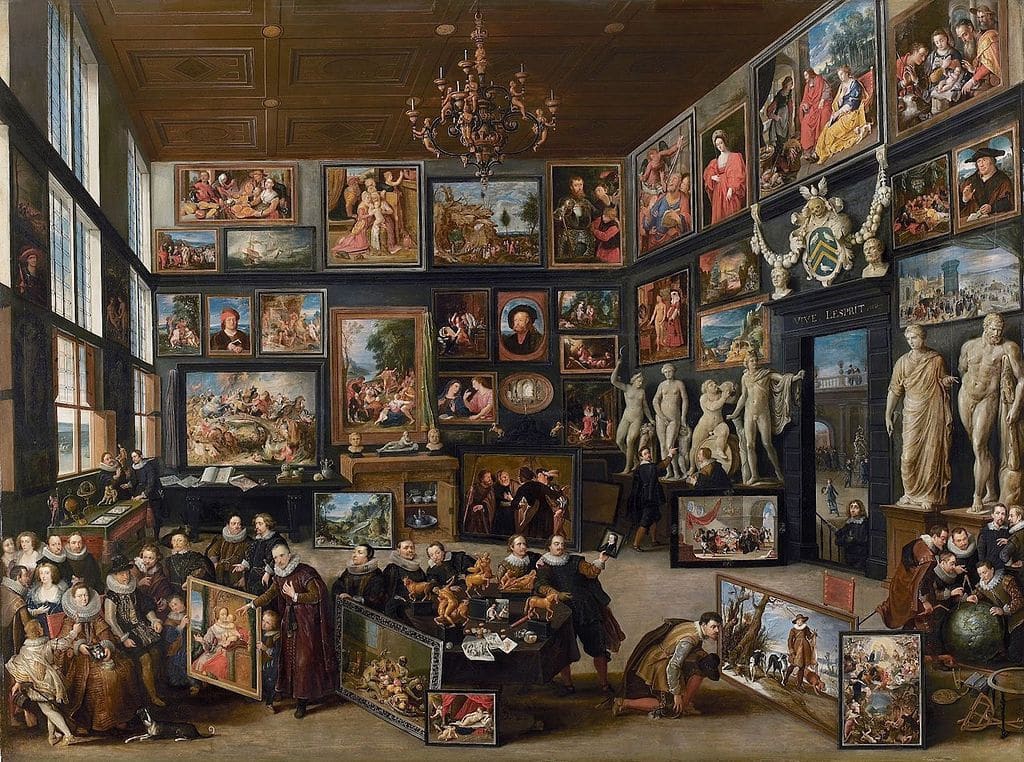The History of Art Collecting trilogy presents a series of articles outlining the art collection as we know it today. In the first part, we highlight collecting practices from antiquity to the Renaissance.
For centuries humans have documented and preserved stories and cultural relics through art collecting practices. Little do many know that buying a contemporary painting today contributes to how future generations will study our present.
Embarking on an art historical journey, we unravel the intricate story of art collection, a practice that has withstood the test of time, taking on various forms and roles. From its origins as an act of temple worship in Ancient Greece to its evolution into a multifaceted cultural phenomenon, the roots of collecting antiquities run deep.

In the heart of Ancient Greece, the practice of collecting art emerged not just as a possession but as an offering to the deities. The very term “museum” finds its etymological roots in the Greek word mouseion, signifying a “seat of the muses.” During the Hellenistic period, sanctuaries became sacred repositories for treasures, playing crucial roles in ritual acts and acting as a conduit between devotees and deities.
What sets this ancient practice apart is the meticulous inventory process employed. Athenian devotees, in the 5th century BCE, crafted a sophisticated three-category system–paradosis, exetasmos, and kathairesis–categorizing objects based on their function and purpose. Beyond the systematic nature of this culture, the objects housed in these sanctuaries exuded both a devotional aura and an aesthetic charm.

Delving into the essence of human behavior, philosopher Immanuel Kant posits that the allure of art and objects lies in their aesthetic appeal and potential utility. This theory not only illuminates Ancient Greek antiquarian culture but also underscores the universal phenomenon of collecting. It is in these Hellenistic traditions that we find the ancestral roots of the collecting practices that continue to thrive in modern society.
As time unfolded, art collections continued to evolve, adapting to the changing dynamics of different eras. Each epoch, shaped by its unique cultural and societal forces, left an indelible mark on the practice of collecting. Today, as we immerse ourselves in the rich tapestry of art history, we discover echoes of these ancient traditions resonating in the diverse collections that grace museums and galleries worldwide.
The influence of Ancient Greek practices is not confined to the past; it permeates the contemporary art world. The meticulous categorization and appreciation for both the functional and aesthetic aspects of art, as seen in the Hellenistic period, continue to shape the way we approach and value art today. From galleries showcasing curated exhibits to individual collectors curating their personal collections, the legacy of the Ancient Greek art collection lives on, leaving an enduring impact on the art landscape.
In the intricate political tapestry of art history, the saga of the Elgin Marbles between Greece and Britain unfolds. These classical Greek sculptures, once adorning the Parthenon in Athens, became a subject of controversy when Lord Elgin, a British ambassador to the Ottoman Empire, removed them in the early 19th century. The debate over the rightful ownership and restitution of the Elgin Marbles remains a poignant example of the intersection between art, politics, and cultural heritage. As the dialogue continues, it adds a complex layer to the ongoing narrative of art collection, reminding us that the significance of art extends beyond aesthetics, intertwining with the broader issues of identity, heritage, and diplomatic relations.

Beyond the realms of art and politics, Ancient Greece continues to captivate present-day society as a model for societal ideals. The enduring legacy of Greek philosophy, democracy, and artistic achievements resonates in contemporary thought and governance. Concepts such as individual rights, civic participation, and the pursuit of knowledge are deeply rooted in the ideals of Ancient Greece. In this light, the Hellenistic traditions of art collection serve not only as historical artifacts but as timeless inspirations, fostering a connection between the past and the present. As we navigate the complexities of the modern world, the echoes of Ancient Greece persist as guiding principles, shaping our perceptions of culture, art, and societal values.
In the forthcoming section, we will delve deeper into the timeline of collecting practices, exploring another profoundly influential period–the Italian Renaissance. Often hailed as a golden era in art history, the Italian Renaissance holds a special place in the hearts of many contemporary artists, who perceive its art as the epitome of fine art. This period, spanning from the 14th to the 17th century, witnessed an unparalleled flourishing of artistic creativity, marked by the genius of renowned masters such as Leonardo da Vinci, Michelangelo, and Raffaello. For many contemporary artists, the Italian Renaissance serves as a wellspring of inspiration and aspiration. The artistic achievements of this period set a standard of excellence that resonates across the centuries. The meticulous techniques, attention to detail, and the pursuit of perfection exhibited by the Renaissance masters continue to be revered and emulated by artists today. In the absence of the preservation of these cultural and historical treasures, the contemporary art world would find itself without a formal model to follow.
0 thoughts on “The History of Art Collecting: Exploring the Ancient Greek Origins”